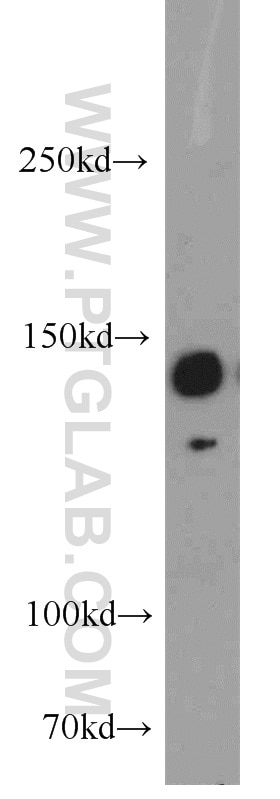Validation Data Gallery
Tested Applications
| Positive WB detected in | HeLa cells |
Recommended dilution
| Application | Dilution |
|---|---|
| Western Blot (WB) | WB : 1:500-1:1000 |
| It is recommended that this reagent should be titrated in each testing system to obtain optimal results. | |
| Sample-dependent, Check data in validation data gallery. | |
Product Information
20983-1-AP targets BRIP1(C-terminal) in WB, ELISA applications and shows reactivity with human samples.
| Tested Reactivity | human |
| Host / Isotype | Rabbit / IgG |
| Class | Polyclonal |
| Type | Antibody |
| Immunogen | Peptide 相同性解析による交差性が予測される生物種 |
| Full Name | BRCA1 interacting protein C-terminal helicase 1 |
| Calculated molecular weight | 141 kDa |
| Observed molecular weight | 140-150 kDa |
| GenBank accession number | NM_032043 |
| Gene Symbol | BACH1/BRIP1 |
| Gene ID (NCBI) | 83990 |
| RRID | AB_2878782 |
| Conjugate | Unconjugated |
| Form | Liquid |
| Purification Method | Antigen affinity purification |
| UNIPROT ID | Q9BX63 |
| Storage Buffer | PBS with 0.02% sodium azide and 50% glycerol , pH 7.3 |
| Storage Conditions | Store at -20°C. Stable for one year after shipment. Aliquoting is unnecessary for -20oC storage. |
Background Information
BRIP1, also named as BACH1 and FANCJ, belongs to the DEAD box helicase family and DEAH subfamily. It is a DNA-dependent ATPase and 5' to 3' DNA helicase required for the maintenance of chromosomal stability. It is involved in the repair of DNA double-strand breaks by homologous recombination in a manner that depends on its association with BRCA1. Defects in BRIP1 are a cause of susceptibility to breast cancer (BC). Defects in BRIP1 are the cause of Fanconi anemia complementation group J (FANCJ). The antibody is specific to BRIP1.
Protocols
| Product Specific Protocols | |
|---|---|
| WB protocol for BRIP1(C-terminal) antibody 20983-1-AP | Download protocol |
| Standard Protocols | |
|---|---|
| Click here to view our Standard Protocols |
